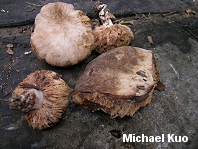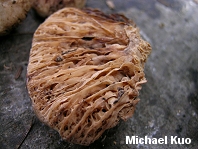| Major Groups > Oddballs & Misfits > Gasteroid Gilled Mushrooms & Boletes > Arcangeliella desjardinii |
| Major Groups > Gilled Mushrooms > Pale-Spored > Lactarius > Arcangeliella desjardinii |

|
Arcangeliella desjardinii [ Basidiomycetes > Russulales > Russulaceae > (Arcangeliella) Lactarius . . . ] by Michael Kuo Arcangeliella desjardinii looks like a malformed Lactarius--which is more or less exactly what it is. The genus Arcangeliella contains "gasteroid," Lactarius-like mushrooms that have poorly formed gills; they have lost the ability to forcibly discharge their spores and apparently rely on animals or rain drops for spore dispersal. In North America species of Arcangeliella are found primarily in the west (often in dry, warm regions). DNA evidence supports the idea that species of Arcangeliella, which produce Lactarius-like milk and share microscopic features with Lactarius, should probably be folded into the genus Lactarius (see the page on the Russulaceae for more information). However, unlike Among the species of Arcangeliella, Arcangeliella desjardinii can be recognized by its relatively large, brownish to olive brown cap; the reddish to brownish stains created by its milk; and its apparent preference for coastal ecosystems in northern California. Description: Ecology: Mycorrhizal (perhaps with Douglas-fir); growing in coastal ecosystems in northern California; winter. Cap: 4-5 cm; convex becoming flat or shallowly depressed; dry; fairly smooth; the margin at first inrolled; dark brown to olive brown, fading to tan or olive tan. Pseudogills: Irregular and contorted; often vein-like; branching; yellowish. Stem: 3-4.5 cm long; up to 1.5 cm thick; more or less equal; dry; colored like the cap or paler. Flesh: White; unchanging on exposure. Milk: White; drying reddish to brownish on the pseudogills. Odor and Taste: Not distinctive. Spore Print: Not obtainable. Microscopic Features: Spores 7.5-10.5 x 6.5-9.5 µ; globose to subglobose; ornamented with amyloid ridges forming a partial to complete reticulum. Pileipellis a tangled trichoderm of hyphae REFERENCES: Thiers, 1984. (Thiers, 1984.) This site contains no information about the edibility or toxicity of mushrooms. |
© MushroomExpert.Com |
|
Cite this page as: Kuo, M. (2007, May). Arcangeliella desjardinii. Retrieved from the MushroomExpert.Com Web site: http://www.mushroomexpert.com/arcangeliella_desjardinii.html |

